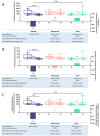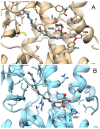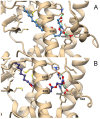Beneficial Effects of Akkermansia muciniphila Are Not Associated with Major Changes in the Circulating Endocannabinoidome but Linked to Higher Mono-Palmitoyl-Glycerol Levels as New PPARα Agonists
- PMID: 33477821
- PMCID: PMC7832901
- DOI: 10.3390/cells10010185
Beneficial Effects of Akkermansia muciniphila Are Not Associated with Major Changes in the Circulating Endocannabinoidome but Linked to Higher Mono-Palmitoyl-Glycerol Levels as New PPARα Agonists
Abstract
Akkermansia muciniphila is considered as one of the next-generation beneficial bacteria in the context of obesity and associated metabolic disorders. Although a first proof-of-concept of its beneficial effects has been established in the context of metabolic syndrome in humans, mechanisms are not yet fully understood. This study aimed at deciphering whether the bacterium exerts its beneficial properties through the modulation of the endocannabinoidome (eCBome). Circulating levels of 25 endogenous endocannabinoid-related lipids were quantified by liquid chromatography with tandem mass spectrometry (LC-MS/MS) in the plasma of overweight or obese individuals before and after a 3 months intervention consisting of the daily ingestion of either alive or pasteurized A. muciniphila. Results from multivariate analyses suggested that the beneficial effects of A. muciniphila were not linked to an overall modification of the eCBome. However, subsequent univariate analysis showed that the decrease in 1-Palmitoyl-glycerol (1-PG) and 2-Palmitoyl-glycerol (2-PG), two eCBome lipids, observed in the placebo group was significantly counteracted by the alive bacterium, and to a lower extent by the pasteurized form. We also discovered that 1- and 2-PG are endogenous activators of peroxisome proliferator-activated receptor alpha (PPARα). We hypothesize that PPARα activation by mono-palmitoyl-glycerols may underlie part of the beneficial metabolic effects induced by A. muciniphila in human metabolic syndrome.
Trial registration: ClinicalTrials.gov NCT02637115.
Keywords: Akkermansia muciniphila; endocannabinoidome; endocannabinoids; human; metabolic syndrome; mono-palmitoyl-glycerol; obesity; peroxisome proliferator-activated receptor alpha (PPARα).
Conflict of interest statement
P.D.C. and W.M.d.V. are co-founders of A-Mansia Biotech SA. A.E., P.D.C, C.D. (Céline Druart), W.M.d.V. are owners of patents on microbiota and metabolic diseases. C.D. (Céline Druart) is currently an employee at A-Mansia Biotech SA. The other authors declare no conflict of interest.
Figures






References
Publication types
MeSH terms
Substances
Supplementary concepts
Associated data
Grants and funding
LinkOut - more resources
Full Text Sources
Other Literature Sources
Medical

